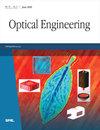Cost-effective, DIY, and open-source digital lensless holographic microscope with distortion correction
IF 1.2
4区 工程技术
Q4 OPTICS
引用次数: 0
Abstract
Digital lensless holographic microscopy (DLHM) allows the design of cost-effective systems using off-the-shelf materials, making this type of lensless microscope accessible to many users worldwide. However, these materials may have a limited optomechanical performance that is aggravated due to the sought compactness and the intended cost-effective manufacturing process. This problem particularly affects the illumination source, which is of critical importance for DLHM, as it defines the optical performance of the microscope. While recent reports show that the required point source can be built from a low-cost laser diode coupled to an also low-cost aspheric lens, the resulting illumination has a distorted wavefront that limits the performance of the microscope. A simple homemade setup to correct the distortion of such illumination source and its integration into a compact, cost-effective, DIY, and open-source-certifiable digital lensless holographic microscope, is presented. The distortion-corrected DLHM is validated by imaging calibrated test targets and biological samples, achieving a 12-fold extension on the distortion-free magnification range of previous designs and a doubling of the effective spatial resolution without significant increments in its overall cost.具有畸变校正功能的低成本、DIY 和开源数字无透镜全息显微镜
数字无透镜全息显微镜(DLHM)可以使用现成的材料设计出具有成本效益的系统,使全球许多用户都能使用这种无透镜显微镜。然而,这些材料的光学机械性能可能有限,而且由于所追求的紧凑性和预定的高性价比制造工艺,这种问题更加严重。这个问题尤其影响到照明光源,而照明光源对 DLHM 至关重要,因为它决定了显微镜的光学性能。虽然最近的报告显示,所需的点光源可以由低成本的激光二极管和同样低成本的非球面透镜耦合而成,但由此产生的照明波面扭曲限制了显微镜的性能。本文介绍了校正这种照明光源畸变的一种简单自制装置,并将其集成到一台结构紧凑、成本效益高、可 DIY 且通过开源认证的数字无透镜全息显微镜中。经过畸变校正的 DLHM 通过对校准过的测试目标和生物样本进行成像进行了验证,其无畸变放大倍率范围比以前的设计扩大了 12 倍,有效空间分辨率提高了一倍,而总体成本却没有显著增加。
本文章由计算机程序翻译,如有差异,请以英文原文为准。
求助全文
约1分钟内获得全文
求助全文
来源期刊

Optical Engineering
工程技术-光学
CiteScore
2.70
自引率
7.70%
发文量
393
审稿时长
2.6 months
期刊介绍:
Optical Engineering publishes peer-reviewed papers reporting on research and development in optical science and engineering and the practical applications of known optical science, engineering, and technology.
 求助内容:
求助内容: 应助结果提醒方式:
应助结果提醒方式:


